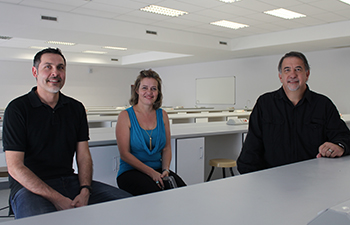Latest News Archive
Please select Category, Year, and then Month to display items
14 June 2024
|
Story Anthony Mthembu
|
Photo Suplied
 Jeremiah Hlahla, a UFS student completing his PhD in Botany at the University of Debrecen as part of an exchange initiative funded by the Erasmus+ Mobility Programme.
Jeremiah Hlahla, a UFS student completing his PhD in Botany at the University of Debrecen as part of an exchange initiative funded by the Erasmus+ Mobility Programme.
As part of an exchange initiative facilitated by the Erasmus+ Mobility Programme, Jeremiah Hlahla, a student at the University of the Free State (UFS), is nearing the completion of his PhD studies at the University of Debrecen in Hungary. Hlahla’s journey, which began in February 2024 and is set to conclude in July 2024, has been a remarkable learning opportunity. “As a first time-traveller to Europe, I have thoroughly enjoyed engaging with people from different countries and cultures,” he said.
The benefits of international collaboration
Hlahla is currently pursuing a PhD in Botany, focusing on plant stress physiology. “My current PhD project investigates the physiological, biochemical and morphological responses of vegetable-type soybean, or edamame, to combined drought and heat stress,’’ he explained. He considers the University of Debrecen the ideal institution to complete his research due to its extensive expertise and resources in similar projects. He noted that his colleagues at Debrecen conduct significant work on plant protection against biotic and abiotic stresses, including salt and drought stress, as well as proteins and amino acids in barley and other legumes.
Given the vast knowledge available on similar projects, Hlahla has found substantial engagement with his work at the University of Debrecen. “Upon arrival, I delivered an introductory lecture presenting my UFS project on the synergistic effects of combined drought and heat stress on the physiology and biochemistry of edamame. It was an engaging session as everyone could relate to my work and asked many questions,’’ he said.
Insights gained from the exchange
Hlahla has also gained valuable lessons that will assist him in his research career, including biotechnology and physiology tools. “I learned how to prepare samples and use high-performance liquid chromatography (HPLC) and reversed-phase ultra-high-performance liquid chromatography (UHPLC) to quantify proteins and amino acids,’’ he said. These techniques are beneficial not only for his current work but will also support future soybean research.
As his experience at the University of Debrecen nears its end, Hlahla reflects on the collaborations and friendships he has formed, which stand out as a significant highlight.
Oxford professor unlocks secrets of DNA
2017-03-31

From left are: Dr Cristian Capelli, Associate Professor
of Human Evolution at Oxford University;
Dr Karen Ehlers, Senior Lecturer and Prof Paul Grobler,
both from the Department of Genetics at the UFS.
Photo: Siobhan Canavan
Many people are interested to know more about their history and origins, and with the help of genetics, it is possible to provide more information about one’s roots.
During a lecture at the Department of Genetics at the University of the Free State (UFS), Dr Cristian Capelli, Associate Professor of Human Evolution at Oxford University in the UK, addressed staff members and students on the history of our species.
Reconstructing the history of human population
With his research, titled: People on the move: population structure and gene-flow in Southern Africa, Dr Capelli looks at reconstructing the history of human populations, focusing mainly on how the different human populations are related, as well as how they exchange genes.
He said this research could be of great significance to the medical field too. “Knowing what the genetic make-up of individuals is, can give us some information about their susceptibility to diseases, or how they would react to a given medicine. Therefore, this knowledge can be used to inform health-related policies.”
Combining individual histories of multiple people
To understand this research more clearly, Dr Capelli explained it in terms of DNA and how every individual receives half of their DNA from their mother and half from their father just as their parents had received theirs from their parents. And so it goes from generation after generation. Each individual stores a part of their ancestors’ DNA which makes up the individual genetic history of each person.
“If we combine these individual histories by looking at the DNA of multiple people, we can identify the occurrences that are shared across individuals and therefore reconstruct the history of a population, and in the same way on a larger scale, the history of our own species, homo sapiens.